How to tackle the current water shortage, and the one on the horizon
Catalonia has declared a drought-induced “state of exceptionality” , tightening the restrictions already in place on many uses of water with the aim of safeguarding the population’s water supply. The situation is serious, and simply folding our arms and hoping for rain is not enough. We need to tackle the problem using all the scientific knowledge and evidence available, and to wake up to the fact that this will happen again and again unless we make major changes. Some scientific proposals involve rethinking our approach to water consumption, which is currently unfettered in the interests of “prosperity”, while others emphasize restoring and protecting hydrological systems, such as rivers, streams and aquifers, and adopting a new system of knowledge-based, participatory governance. All this is explained in full below, based on a discussion with CREAF’s water management expert, Annelies Broekman .
In 2019, Cyprus, Malta, Greece, Portugal, Italy and Spain experienced the worst seasonal water scarcity conditions in the European Union.
First of all, a clear distinction should be made between the terms drought and water scarcity. A (meteorological) drought is a prolonged lack of precipitation, while scarcity (also known as hydrological drought) refers to there not being enough water available for all the different things we use it for. Water scarcity (rather than drought) can be gauged by means of the water exploitation index (WEI), an indicator that reflects the pressure on resources of fresh water and measures annual water consumption as a proportion of the total available. In 2019, according to the WEI, Cyprus, Malta, Greece, Portugal, Italy and Spain experienced the worst seasonal water scarcity conditions in the European Union , which goes to show that we consume too much water for our system to handle even in normal times. In times of recurrent or prolonged meteorological drought, such as the critical situation we are facing at present, we all too often blame the climate and overlook the real culprit: the chronic demand for water our unsustainable approach to development entails. Such is the thirst for water in every sector that we consume it to excess, outstripping the natural capacity of the resources available to us.
The Sau and Susqueda reservoirs on 12 February 2019 and 2 February 2023. Sentinel 2 satellite images with RGB (IRp, IRoc, V) at 10m resolution. Source: Grumets.
So, what can we do? In the short term, the Government of Catalonia’s Special Drought Plan for each drainage basin paves the way for a proactive approach to dealing with the challenge the water shortage poses, with clear rules for everyone. As theCatalan Water Agencystates, “the Plan is based on knowledge and analysis of the recurrent droughts Catalonia has experienced in the last 80 years, making it possible to establish patterns of vulnerability for future events. It implements continuous preventative monitoring of reserves to ensure that measures are taken before a state of alert arises, well in advance of them falling to worrying levels.” Thanks to that strategy, “in response to a hypothesis of potential drought, the first preparatory measures begin to be taken up to eight months prior to a state of alert being declared.”
The Plan envisages the use of technology to produce water. That means managing the scarcity of water by producing enough to meet demand, through reuse and desalination for example. While useful in the short term for helping to cope with isolated droughts, such technology-based solutions are not workable in the long term because of their economic, energy and environmental cost.
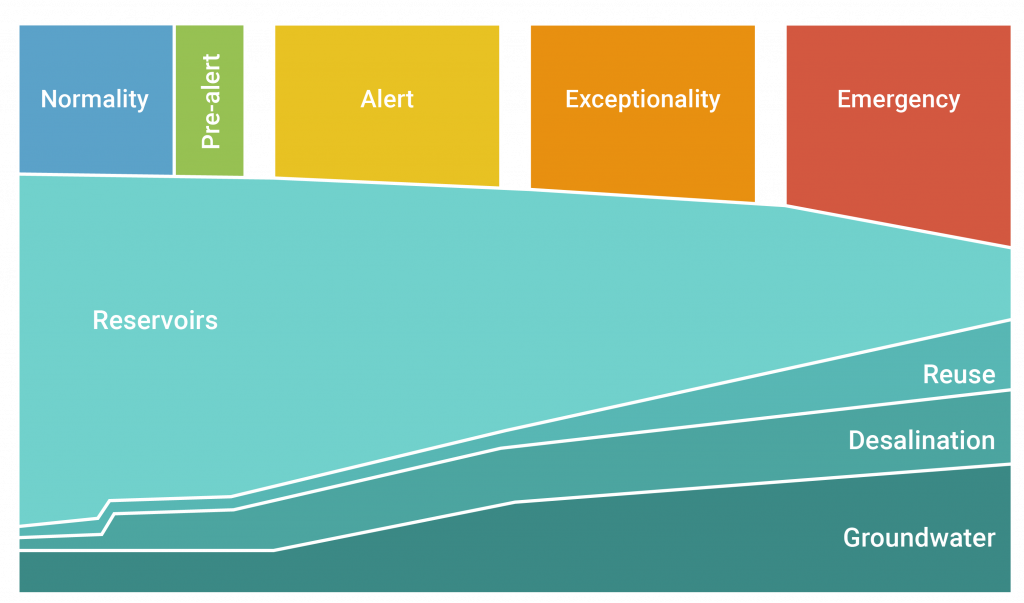
The cost of water production
Over and above its economic cost, producing water in desalination plants has a huge environmental impact.
In the case of desalination, for example, Catalonia has two desalination plants, which provide the Aigües Ter-Llobregat (ATL) supply system with 80 hm3 of drinking water per year: one on the Tordera River (with a capacity of 20 hm3/year) and the other on the Llobregat River (60 hm3/year). There are plans to spend 250 million euros on extending the Tordera plant and, at a cost of hundreds of millions of euros, to create a new plant with a capacity of 20 hm3/year on the Foix River, all in the next five years. Doing so would give a total potential production capacity of 140 hm3/year. Over and above the economic costinvolved, producing water in this way has a huge environmental impact, primarily because of the energy consumed in the process. Despite the consumption rate having fallen substantially, from 8 kWh/m3 in the first plants built in the 1970s3 to 2.3 kWh/m3 in today’s most optimized systems, it still stands at around 4 kWh/m3 on average. Furthermore, that consumption generates atmospheric emissions. Another important consideration is that, in addition to the construction of the plant itself, conveying its desalinated water to wherever it is necessary requires expensive new infrastructures that will need maintenance and have a limited technical lifetime. And on top of all that, the discharge of brine from desalination plants is harmful to marine flora.
Recycling water rather than returning it to rivers causes a reduction in flows, with some rivers ceasing to function normally and life in them dying out.
An alternative is reclaimed water, i.e. recycled water from treatment plants, which can be used for municipal purposes, for groundwater recharge, or in industry or agriculture. However, besides the cost of treatment itself, water reclamation has such a great environmental impact that it is not feasible on a large scale. Unrecycled treated water is returned to rivers, improving circulating flows and helping revive river ecosystems. The Besòs River, for example, consists entirely of treated water. What would happen if all such water were recycled and none returned to rivers? There would be a reduction in flows, and some rivers would no longer function normally and life in them would die out. Water production can only help reduce vulnerability if it provides a substitute to be used instead of water taken from the environment.
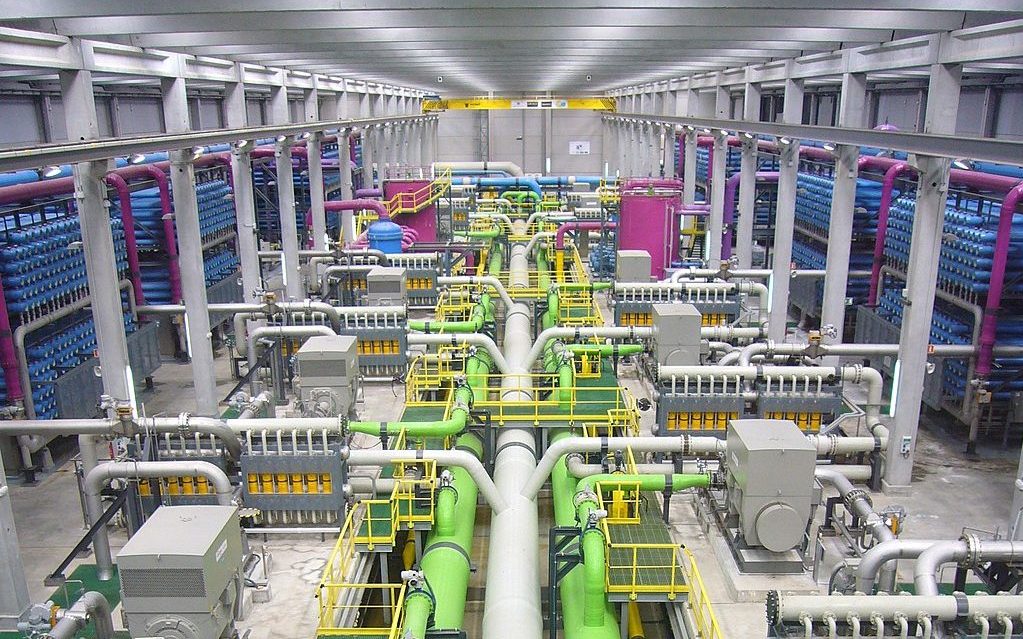
So, water production has a huge environmental, energy and economic cost, and can be a solution only occasionally, in crisis situations. But what if the lack of water becomes chronic rather than transient? Droughts are commonplace in the Mediterranean region, and the Iberian Peninsula is no exception. However, science has shown that climate change will bring increasingly frequent and severe droughts, as the Mediterranean region is warming 20% faster than the global average and its rainfall is expected to decrease by between 20% and 50% by the year 2100. To adapt to that new scenario and reduce our vulnerability to a shortage of rain, we need solutions that can ensure water availability in the very long term.
In the case of agricultural irrigation, the installation of water-saving technologies has proven to lead to increased total water consumption.
The smartest and most immediate solution would be to rein in our insatiable thirst, to curb demand and realize that our socio-economic way of life is unsustainable. We must reflect on our model of agriculture, urban development, tourism and industry with the aim of reducing the total amount of water we use, limiting ourselves to a quantity that will not disrupt natural cycles. Above all, we need a change in mentality, to prioritize the health of bodies of water and natural ecosystems instead of seeking to meet all demands. That is the only way to render water and our use of it less vulnerable to global change. Restoring nature in such a way would be an even better option than using water more efficiently, because the latter entails a rebound effect. In the case of agricultural irrigation, for example, the installation of water-saving technologies has proven to lead to increased total water consumption. That may seem counterintuitive, but it is explained by the Jevons paradox: to recoup their investment, farmers step up production to earn more money per cubic metre of water by planting crops that are more profitable — but may require more water — and/or harvesting more frequently each year. Each drop of water thus yields more, so greater efficiency is achieved, but at the price of a reduction in overall water availability in the corresponding basin.
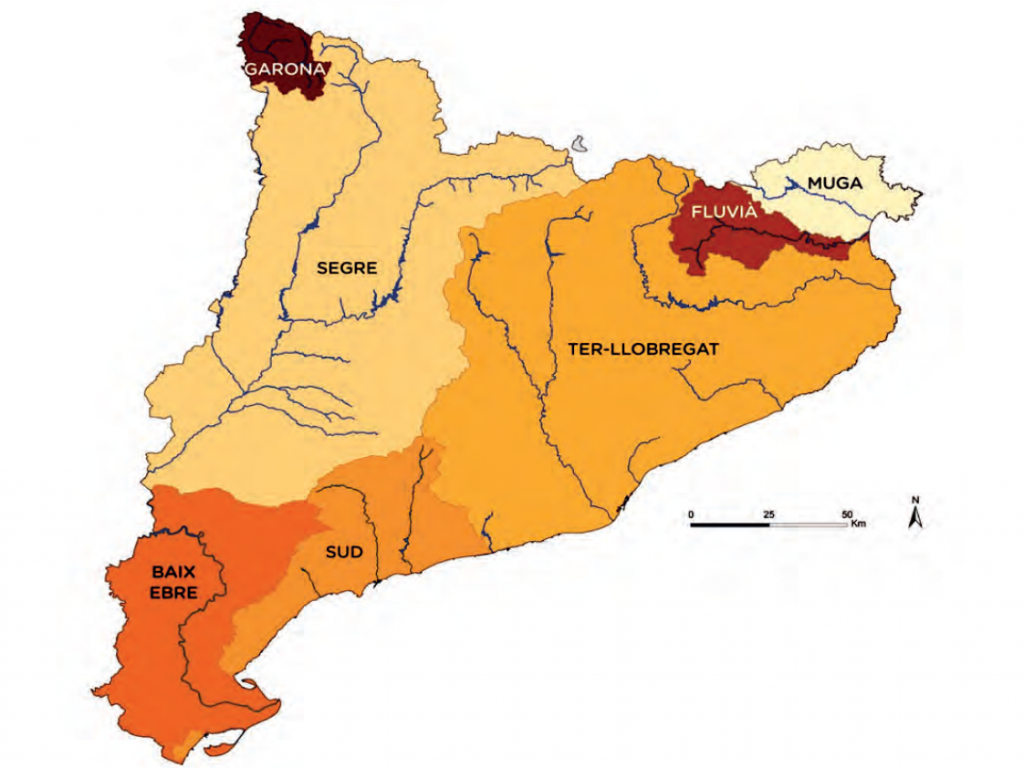
Nature is the solution
Such a change of mentality needs to start today, as does another vital undertaking, that of beginning to meaningfully implement measures to restore, maintain or improve our hydrological systems. Where does the water we use come from? Our tap water comes from a drainage basin that contains surface water, groundwater and/or water produced by means of desalination or recycling. Water production has its limitations, as mentioned previously, so looking after, protecting and restoring natural water sources, rivers and aquifers, is an urgent priority in Catalonia.
Protecting aquifers is a strategy with a long-term perspective because they act as natural reservoirs.
Protecting aquifers is a strategy with a long-term perspective because they act as natural reservoirs, gradually soaking up and holding water like sponges, and they are fairly resistant to variations in temperature and precipitation. Furthermore, if levels of groundwater fall too much, contaminants build up in it and, in coastal areas, sea water finds its way into it, lowering the quality of the water we drink. It is therefore necessary to start allocating resources to groundwater decontamination, to stop filling up river and drainage areas with cement, to refrain from channelling rivers and altering their courses, to act against illegal wells that make it possible to sidestep water restrictions, and to reduce the widespread overexploitation of aquifers.


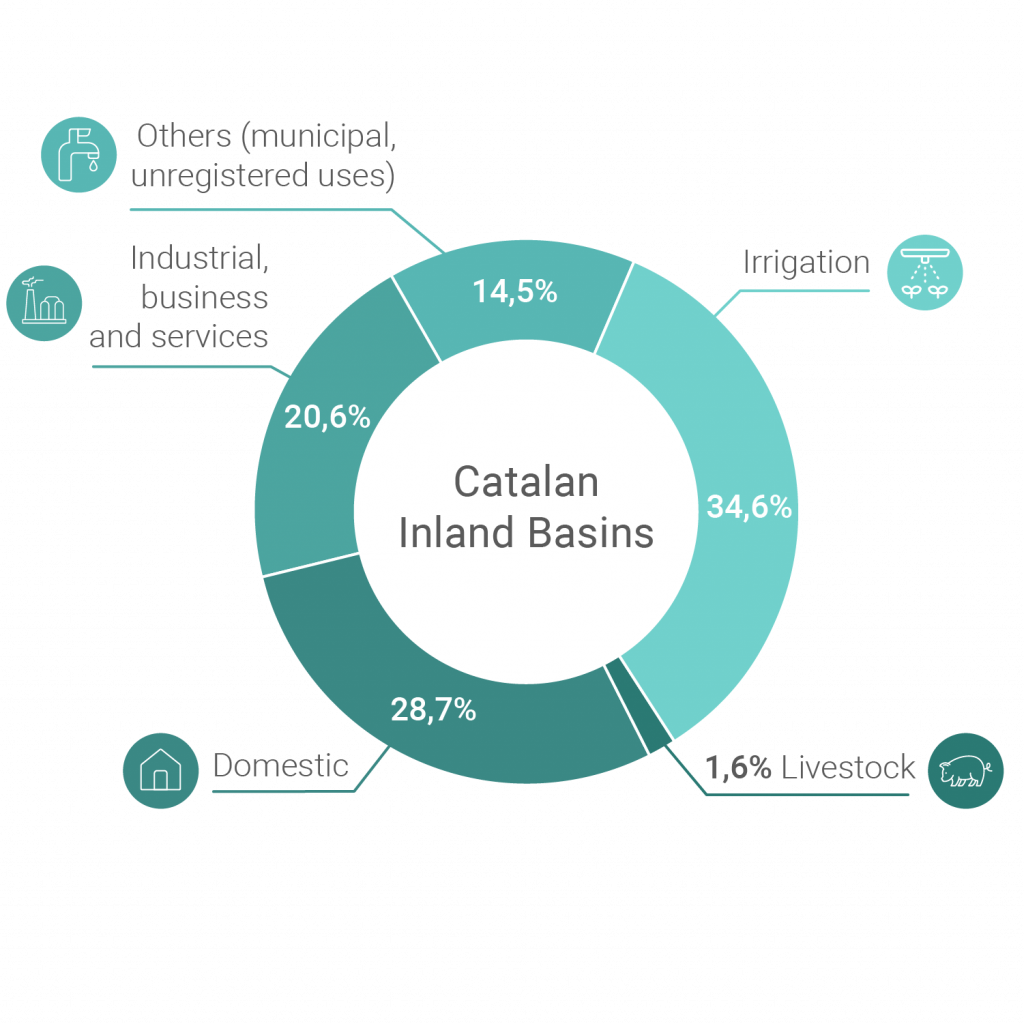
Anterior
Següent
River conservation is a nature-based solution that could help mitigate the effects of drought.
As far as rivers are concerned, we urgently need to restore their environment and their courses. River conservation is a nature-based solution that could help mitigate the effects of drought, as rivers are an essential part of the water cycle and crucial to providing ecosystems and humans with quality fresh water. Such conservation involves restoring wetlands, rivers and streams, establishing adequate environmental flows, reviving riverside woodland, and making society aware of the fragility of the river environment.
We also need to think long and hard about the strategy of constructing more reservoirs and locks, infrastructures that have a major environmental impact because, like clots in an artery, they obstruct the flow of water in a river and alter its natural rhythm. Furthermore, the water that collects in reservoirs is mainly used for irrigation and electricity generation, purposes linked with economic interests rather than with nature’s rhythms. For example, many rivers are used as irrigation canals and are full in summer when, in the Mediterranean region, their flow would naturally be low. The artificial manipulation of flow rates is detrimental to the way a river functions: its flow decreases too much, contaminants build up in it, its water temperature rises, and its natural cleansing mechanisms are affected, all of which add up to a loss of water quality. On top of that, the ecosystems linked to the river become more vulnerable, something invasive species take advantage of, just as the giant reed has in Catalonia. And reservoirs and locks do not only alter rivers’ flows; they also result in the water downstream being insufficient to transport sediment, which forms riverbeds and deltas and takes sand to the coast. A case in point is the Ebro Delta, which has been badly affected by the retention of sediment in the basin’s reservoirs. In addition to sand, it is vital that fresh water reaches the sea, to regulate its physicochemical conditions and provide nutrients, functions that are essential for populations of fish and other organisms.
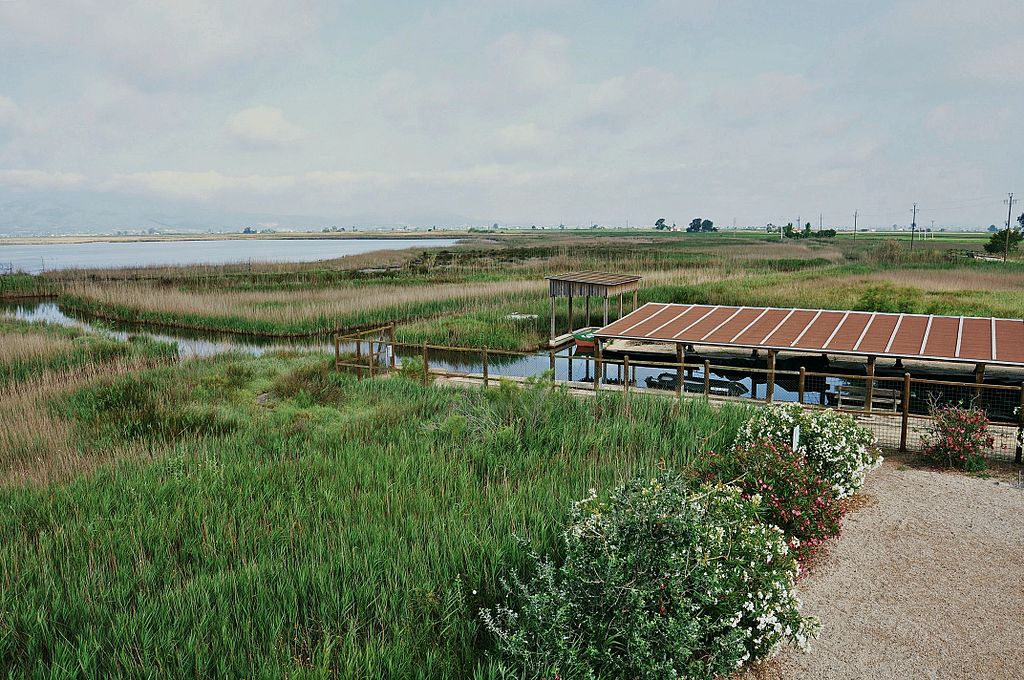
Co-creating the water management model of the future
It is not possible for all the structural changes referred to here to take place overnight, and their promotion cannot be unidirectional. Thus, it is necessary for society as a whole to engage in deep reflection and co-create action plans adapted to each territory. A holistic view of each basin is required to that end, integrated planning that takes into account that each hydrological system is a unique hydro-social system in which water has very different functions and is looked upon in very different ways, and must be available to citizens at a fair price.
It is necessary for society as a whole to engage in deep reflection and co-create action plans adapted to each territory.
Co-creation involves establishing forums for deliberation and mutual learning, governance forums whose purpose is to combine scientific information on how hydrological, ecological and social systems work with the knowledge of the production sectors and the insight of local people. In the area of adaptation to climate change, of which water is a cornerstone, examples of such bodies include the Tordera River Delta and Baixa Tordera Committee (Taula del Delta i la Baixa Tordera) and Maresme’s Work Group for Adaptation to Climate Change (Mesa de Treball per l’Adaptació al Canvi Climàtic). Such mechanisms make it possible to consider each basin from every angle and to carry out the kind of integrated planning described previously.
Catalonia’s ingrained thirst can be sated, and a first step consists of respecting water, rivers and aquifers, questioning how much water we need, and reflecting on the economy we want, without exceeding sustainable capacity.. To that end, it is important to work together in forums for dialogue and governance open to all comers, in each of Catalonia’s basins. We need to set up such forums in every basin, to learn, to join forces, to listen to science and to put forward measures for the long term. That is the only way we will be able to tackle Catalonia’s chronic water shortage.







